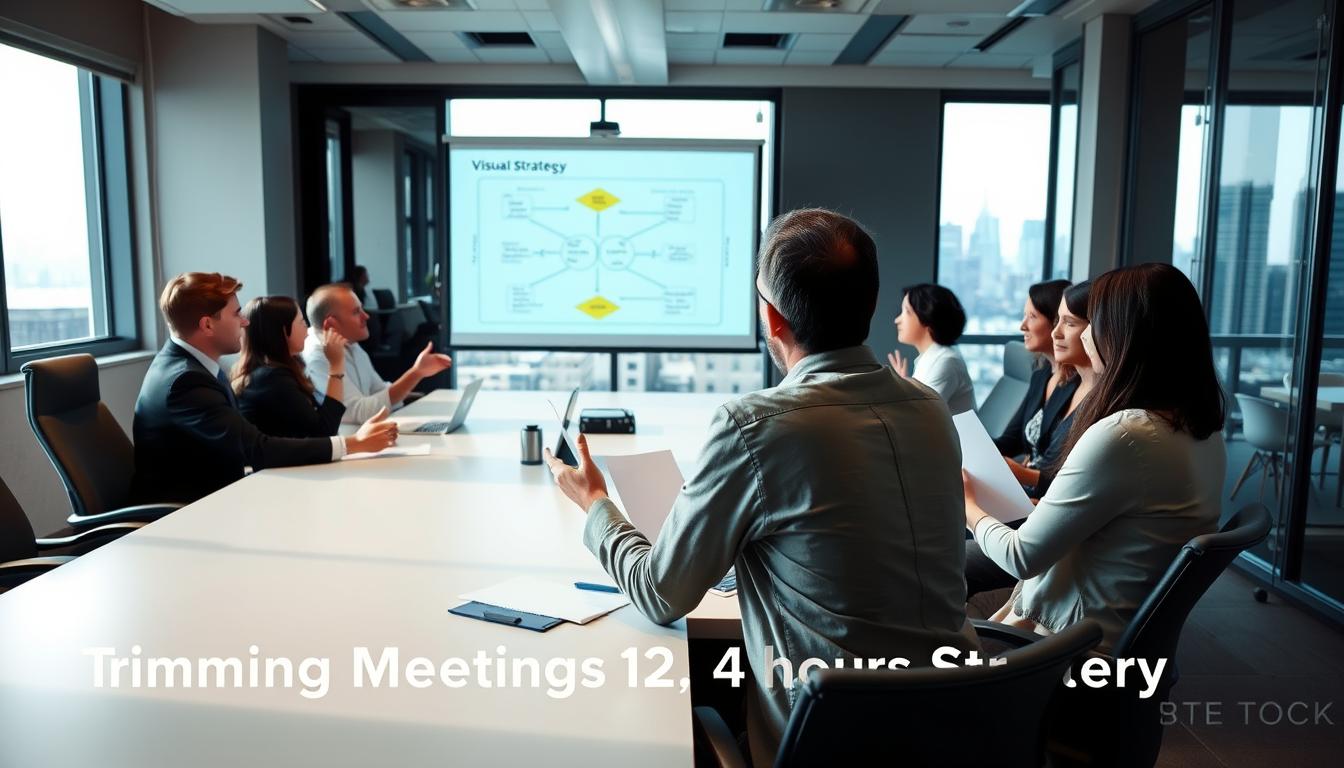In today’s fast work world, good leadership is key to raising productivity and team spirit. Leaders are now in meetings for almost 23 hours a week, a big jump from before. This overflow of meetings can tire people out and make it vital to drop the unnecessary ones.
Understanding the bad impact of too many meetings is important. Leaders should scrap those that block progress and work towards a more effective workspace. It’s all about setting an example, leading to a team culture that values clear goals and teamwork in all they do.
Understanding the Impact of Useless Meetings
Too many meetings are becoming a big problem in lots of organizations. Leaders often feel drowned by them. This can make the work environment not so great. Meetings that aren’t needed take away from the real work, making employees upset. When leaders choose productive work over useless meetings, the workplace feels better.
The Rise of Meeting Overload
In recent times, there’s been a jump in how often and how long meetings are. This is mostly because it’s not always clear what the meetings are for. When meetings go off track, they waste time and make people trust their leaders less. A Gallup study shows only 20% of workers really trust their bosses. This shows how bad meetings can damage confidence.
Consequences on Team Morale and Productivity
Meeting overload does more than just waste time; it hurts how a team feels. Workers check out when meetings seem pointless. Studies have found that bad meetings can cost a lot of productive time each year. It’s important for companies to see this problem and fix it. Doing so can help create a better and more effective work environment.
Identifying Useless Meetings
Knowing which meetings are not needed is key to keeping work flowing smoothly. A lot of meetings just take away from getting work done, especially if they don’t have a clear reason. By spotting certain signs, we can figure out which meetings to skip to make things more efficient.
Signs of a Meeting That Should Be Canceled
- If there’s no clear plan or goal, the meeting might be a waste of time.
- Meetings that don’t stick to important topics or reach goals are likely unnecessary.
- When few people join in, it might mean the meeting isn’t useful to the team.
Assessing Meeting Frequency and Relevance
It’s important to regularly check how often meetings are held. They should only happen if they match the company’s aims and what we need to do. Checking if meetings are still useful can prevent wasting time and resources.
How Leadership Can Lead by Example and Cancel Useless Meetings
Leadership by example is key to changing meeting culture. Leaders need to clearly state the purpose and desired outcomes of every meeting. This makes meetings focused and useful, telling teams each meeting must have a goal.
Defining Clear Meeting Objectives
Setting clear meeting goals helps keep work productive. Leaders must make the goals and what’s expected known to all. This helps everyone know what they need to achieve, which:
- Targets certain results for discussions.
- Makes each person’s role clear during the meeting.
- Points out issues needing a solution.
Leaders who set these guidelines help their teams think carefully about what’s necessary, cutting down on pointless meetings.
Establishing Meeting Norms and Guidelines
Having clear norms and guidelines makes for meetings that work well. These rules make sure everyone values being on time, taking part, and being ready. You might:
- Share an agenda before the meeting.
- Limit how long each topic can take.
- Encourage everyone to speak respectfully and listen well.
With these guidelines, showing leadership through actions can greatly improve how teams work together and make meetings useful.
Creating a Culture of Intentionality in Meetings
To start having intentional meetings, we must first encourage open talking. Team members should feel free to express how they feel about meeting effectiveness. Having a strong system for feedback improves the value of meetings a lot.
Team leaders must ask for opinions on what’s working and what’s not. This ensures everyone’s ideas are heard and appreciated. It helps in refining meeting strategies so they better match company goals.
Encouraging Open Feedback on Meetings
Allowing feedback can change how we see meetings. Everyone should be able to talk about their meeting experiences and offer ideas for better ones. We could have regular times to talk about how useful meetings are.
This constant talk helps in making needed changes. It creates an environment where sharing thoughts is normal and encouraged.
Promoting the Use of Alternative Communication Tools
Choosing the right communication tools helps lessen the need for so many meetings. Tools like Slack, Trello, or Asana provide different ways to work together. They help in making discussions and updates easier without needing a meeting room.
These tools not only save time but also lead to more purposeful talks. Moving to these options can make a team more focused and productive.
The Role of Leadership in Meeting Structuring
Effective meeting structuring boosts teamwork and productivity. Leaders influence meeting success through planned check-ins over random meetings. This helps teams chat efficiently and understand goals clearly.
Implementing Scheduled Check-Ins Instead of Ad-Hoc Meetings
Regular check-ins help teams talk about their progress and tackle problems without interruptions. Leaders can set specific times for these meetings. This makes team members feel important and ready.
Here are the benefits:
- Communication is clear.
- It cuts down on meeting tiredness.
- Focus improves on what actions to take.
Utilizing Digital Platforms for Efficient Communication
Along with meetings, using digital tools helps. Tools like Slack, Microsoft Teams, or Zoom allow for constant team chat. This way, there’s no need for lots of face-to-face meetings. By using these platforms, companies get:
- Easier sharing of info.
- Better involvement from people working remotely.
- More flexible talking, leading to quick replies.
Building Trust Through Transparent Leadership
Transparent leadership is key to creating trust between team members and leaders. By being open about their decisions, leaders make a teamwork-friendly environment. This openness makes employees feel valued, boosting trust. Studies show that when people feel listened to, they work harder and produce more.
Fostering an Environment Where Input is Valued
Leaders who seek feedback build better teams and foster a sense of community. To do this, they can:
- Implementing regular feedback sessions.
- Creating open channels for communication.
- Recognizing contributions during team meetings.
These steps show how important it is to build trust by valuing everyone’s input. When employees feel their opinions matter, they take more responsibility. This leads to a team that works well together.
The Importance of Follow-Up and Accountability
It’s important for leaders to follow up on meetings to keep the team accountable. Checking in on tasks shows leaders’ dedication to success. They can:
- Sending summaries of meeting discussions and action points.
- Setting deadlines for tasks and following up regularly.
- Encouraging team members to share their progress openly.
Actions like these build accountability and trust within a team. Team members become confident in their roles when leaders are transparent and committed. This environment allows individuals to thrive.

Best Practices for Canceling Useless Meetings
In our fast-moving work life, knowing how to cancel meetings can boost productivity. It helps if we check if meetings are really needed and if they add value. This way, team members use their time well, focusing on tasks that push the business forward instead of wasting time.
Evaluating Meeting Necessity and ROI
When deciding to cancel a meeting, think about a few important things:
- Identify meeting goals: Make sure the goals still matter.
- Analyze participation: Check if everyone is involved and adding value.
- Measure outcomes: Look at what past meetings achieved to see if they meet team goals.
- Consider alternatives: Think about other ways to share information without meeting.
Strategies for Communicating Cancellations Effectively
When canceling meetings, good communication keeps team spirit high and shows respect. Here are ways to do it well:
- Notify in advance: Tell everyone early so they can change their plans.
- Provide rationale: Share why the meeting is called off to help everyone understand.
- Encourage feedback: Ask the team how meetings can be better to plan future ones wisely.
- Reinforce communication norms: Suggest quick chats or messages as other ways to stay in touch.
Overcoming Resistance to Reducing Meetings
Some team members might worry about having less communication due to fewer meetings. They think it might cause misunderstandings or less teamwork. Leaders need to clearly explain why cutting down on meetings is good. They should share how it will make everyone more productive.
To change the workplace culture towards less meetings, leaders have important roles. They can:
- Host informational sessions to clarify the benefits of reducing meetings.
- Encourage feedback from team members on their meeting experiences.
- Highlight success stories where reducing meetings has enhanced productivity.
Leaders can lessen worries by talking openly and showing the good that comes from having fewer meetings. This way, they create a place where teamwork can flourish better. It makes sure everyone knows the plan and feels ready to succeed.
Conclusion
Effective leadership is key to cutting out useless meetings, making meetings more productive and boosting work productivity. Leaders should focus on clear communication and showing how to have productive meetings. This sets the example for everyone in the organization.
Leaders must be clear about why each meeting is needed and build trust within their teams. This approach ensures that every meeting is useful. It cuts down on wasted time and lets teams concentrate on their main tasks. This leads to a more united and efficient work setting.
Change starts when leaders take responsibility and listen to feedback. By improving how meetings are run and putting communication first, companies can keep succeeding and making their workplaces better. With continuous effort, leaders can create a positive environment where everyone benefits.



